While I love to eat the traditional veg I grew up on such as broccoli, cauliflower etc, they will only grow in Brisbane during the cool months.
Seeing as I like to eat food all year round I’ve long been interested in the alternatives that will grow well here in the sub-tropics during the hotter months.
Turns out there are lots to choose from and most can be readily sourced these days either over the net, from the local farmers markets or from our network of gardening friends. I will keep adding as I find more.
A lot of this is being transferred from my Brisbane Local Food blog and I will edit as I go along. If anyone feels I have wrong information or you have other information to add, I would love to hear.
Listings are alphabetical by their common name. Follow the links for each plant for more information.
AIBIKA Abelmoschus manihot formerly Hibiscus manihot also ka hibiscus spinach, ibika, bele, vauvau (Fiji), pele (Polynesia), ailan kapis (Vanuatu), tororo aoi (Japan), sunset muskmallow, sunset hibiscus, hibiscus manihot, lettuce tree, Queensland greens
Incredibly prolific and useful summer green that can be eaten raw, steamed, boiled, stir fried or added to stews. Two types that I have seen – the “finger” below and the large leaf (follow the link).
Small easy managed bush that is very easy to grow from cuttings. Cut back at the end of the main cropping period – comes good again with summer rains but remember to make yourself some new plants before this short-lived perennial dies off for good. Flowers are also edible (yet to try them myself).

ARROWROOT Canna edulis also ka Qld Arrowroot
Useful carb tuber and easy enough to grow but I know mine look a bit sad if it gets too dry. They like their moisture. Use the pinkish outside tubers for roasting or whatever takes your fancy. Rather bland in themselves they absorb the flavour of whatever they are cooked with.
Best thing I found out about these at the workshop at Yandina is that the young, curled inner leaves are good cooked as a green (remove the spine). Great for animal fodder or mulch plant.
They also showed us a relatively quick and easy way to make our own Arrowroot flour and Arrowroot and Apple patties.
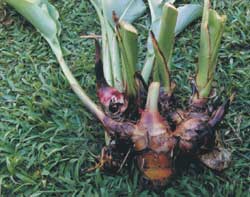
BETEL LEAF Piper sarmentosum also ka wild pepper, kadok, bai cha plu,cha plu, bai som phou, sirih dudu, daun kaduk, betel pepper, la lot. Betel leaf is a completely different plant to Betel pepper Piper betle, which is chewed with betel nut.
Easily grown from rooted cutting the spicy leaves are popular in south east Asian cooking, used raw and cooked. To eat raw in a salad or use as a wrapping the young tender leaves are best. In Thailand, these wraps are a favourite snack, ‘mieng kum’, using an assortment of fillings, like peanuts, shrimps, shallots with lime and raw ginger.
Soaking the leaves in cold water with a little sugar for 2 hours before use subtly alters the flavour. As the leaves are very attractive, they are often used as a base to line platters, with foods arranged on top. The white flower spikes develop into a small fruit that can be eaten.
The plant likes it’s roots kept cool and good sunlight on the leaves. If it becomes a nuisance it’s easy to pull out.
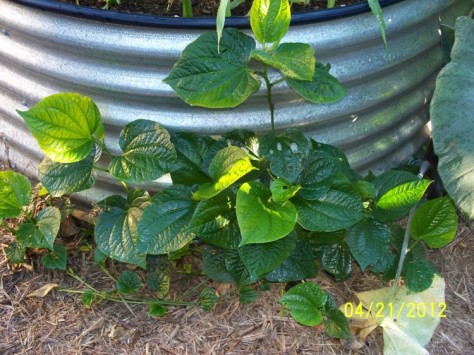

BITTER MELON Momordica charantia, known as bitter melon, bitter gourd, bitter squash or balsam-pear


First time I’ve ever grown these. I made some Bitter Melon Soup with a fruit from a gardening friend a few years back and remember liking it very much. Purported to have many health benefits.
I have one which has turned bright yellow – can’t wait to try the sweet pith when it splits as per below:
As the fruit ripens, the flesh (rind) becomes tougher, more bitter, and too distasteful to eat. On the other hand, the pith becomes sweet and intensely red; it can be eaten uncooked in this state, and is a popular ingredient in some Southeast Asian salads.
When the fruit is fully ripe, it turns orange and mushy, and splits into segments which curl back dramatically to expose seeds covered in bright red pulp.
BRAZILIAN SPINACH Alternanthera sissoo also ka Sissoo, Samba Lettuce.
There’s a heap of these “spinach” plants available now including Egyptian and Ceylon – all quite different, but everyone in the room during the Yandina workshop was unanimous that they liked this hardy little perennial plant to eat. Can be grown in sun or semi-shade. Makes good chook fodder. Can be eaten raw or cooked – Robyn suggested a quick dip in a bowl of boiling water to soften it if using in a salad.
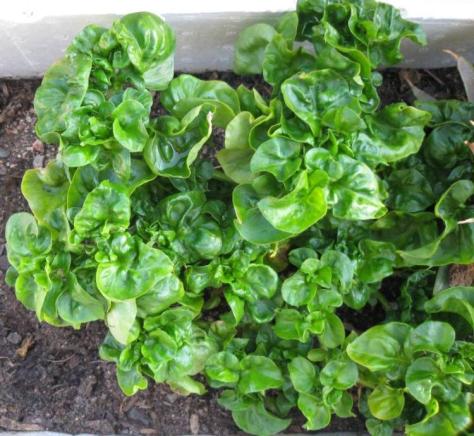
CASSAVA Manihot esculenta
Ok, I admit this one scares me a bit due to the strict rules around the preparation of the tuber. The ladies at the workshop tell me so long as the tuber is prepared within a day of cropping the risk of it producing Cyanide (yes, Cyanide!) are greatly reduced. If you see any dark streaks on your tubers do not eat them! Have also just read that people with a latex allergy (me) could become allergic to it. The foliage on the plant is also poisonous and should not be consumed. Makes me wonder how many people got sick learning how to use this plant.
Harvest the tubers at any time. Best when they are younger and smaller (I had previously been told to wait until my plants died off – apparently not necessary). Cut the skin – it should peel off easily. Cut out the small stringy core. The yellow ones are sweeter to eat (anyone growing these?).
Grate and freeze, or par-cook in serving sized portions and freeze for long term use. Can be boiled, steamed, roasted or turned into flour.
Having said all this, Cassava flour is great stuff to make cakes and desserts with. See Spiced Cassava Cake recipe – very delicious. I played it safe and bought flour ready made from the shop.

CEYLON SPINACH Basella alba also ka Malabar Spinach
A creeper that grows easily from seed the leaves are quite mucilaginous and not to my taste but a lot of people love them.

CHOKO Sechium edule also ka Chayote
Bane of our childhood, the largest fruit were overcooked and served with white sauce, yech. Talk about bland. But way better than that when used correctly they have a delicate flavour that lends itself to many uses.
Easy to grow from a sprouting fruit place it where the roots will be protected from heat but the leaves will get plenty of sun and where it can ramble over something. Do not bury the sprouting fruit but let it rest half covered on the top of the ground.I had one friend killed off three plants I gave him due to burying them
Best eaten young, crisp and sweet like a little apple. Can be used any which way, raw when young in a salad (marinading in lemon juice is sometimes recommended) or in cooking – great fried, roasted, stewed, stir fried.
All parts of the plant are edible from the scrummy leaf tips to the tuber and the fruit. I find the plants thrive for a two or three years with a yearly cut back once the main fruiting is over and then need replacing. They like their water in hot weather.
I really like the white version, gorgeous pearly thing with a few minor spikes, but this one is touchier to grow than the green one and dies off far more easily.
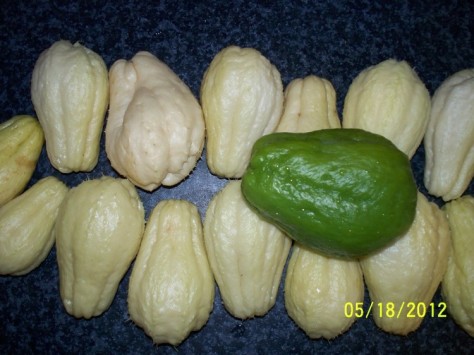
COCOYAM Xanthosoma saggitifolium (a genus of the Arum family)
I really liked this one to eat at the workshop in the Yam & Madagascar Bean salad recipe. Brought back a plant to give it a go.
Pic below -See how the stem joins the leaf right at the pinch point unlike the Tahitian Spinach Xanthosoma brasiliense.

EDAMAME Soybeans.
From Organic Gardening (follow the link for full info)
Edamame (pronounced “eh-dah-MAH-meh”) are vegetable soybeans — that is, you pick them when they’re green, pop them out of the pods and serve them as a side dish or eat them like peanuts, a crunchy snack you munch with a beer. Edamame are an excellent source of high-quality protein — the beans have all of the amino acids, including the 8 not produced in our bodies. Also high in dietary fiber, calcium, phosphorus, potassium, vitamin A and folate. And then there are isoflavones — the powerful plant compounds that have been linked to everything from decreased heart disease to alleviating the symptoms of menopause.

EGYPTIAN SPINACH Corchorus olitorius also ka Molokhia, Malu Khia, Melokheya, Meloukia, Salad Mallow, Jew’s mallow, West African sorrel
A very hardy, fast growing annual to 1m. The young leaves used in salad, older leaves and the shoot tips cooked as spinach and are high in protein. It self-sows readily. I just let these come up by themselves each year from broadcast seed.

Multi useful spice rather than a vegetable. I explained to the group at Yandina, where this stuff grows like a weed, that we have had our problems getting it growing in Brisbane. They have sent me back with a nice chunk out of someones garden. NOTE Thanks to this plant I now have it growing well.

JERUSALEM ARTICHOKE Helianthus tuberosus also ka sunroot, sunchoke, earth apple or topinambour it is a species of sunflower
Jerusalem artichokes produce a large numbers of edible tubers. They are especially good for diabetics as they contain no starch, the carbohydrate is in the form of inulin and laevulin, which are readily metabolised as the natural sugar, laevulose. Tubers should be scrubbed not peeled and can be boiled or baked, when very fresh they can be grated raw in salads.
Beware eating older tubers as they produce a horrendous amount of painful intestinal wind.

JICAMA (pro he-calmer) Pachyrhizus erosus also ka Mexican yam, or Mexican turnip
Definately a favourite of mine. Climber with inedible pods and edible tubers that crops once a year. Grown from seed is the only way I know to propagate it. Delicious eaten raw like an apple, or cut up in salads. Would probably also lend itself to dehydrating.

KANG KONG Ipomoea aquatica also ka Swamp Cabbage, Water Spinach, River Spinach
Both the leaves and stems can be used in cooking. Delicate flavour. I grow mine in a clay pot of soil submersed to the rim in a container of water. Can be grown from cutting or seed. Mine died off in winter and I had to buy a new plant.
Shown here growing in a moist spot.
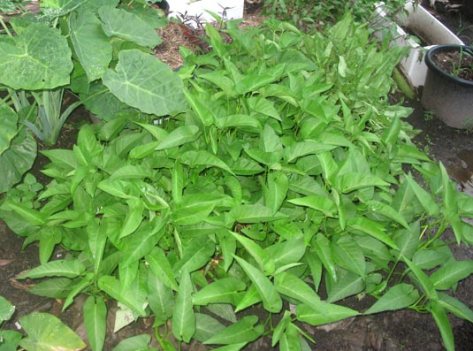
MADAGASCAR BEAN Phaseolus lunatus Lima Beans.
Easy to grow for most – I have had a devil of a time getting one plant established in my garden. I suspect I expected them to be self reliant and didn’t give them enough TLC. My Gran used to boil these in salted water until tender then dish these up as a snack when we were kids. We loved them then and still love them now. Add to soups and stews or salads. Yam & Madagascar Bean salad recipe.
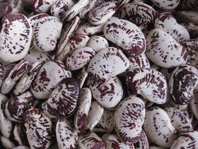
MORINGA Moringa oleifera also ka Drumstick tree and Horseradish tree
Much of the plant is edible by humans or by farm animals. The leaves are rich in protein, vitamin A, vitamin B, vitamin C, and minerals. It is a fast-growing, drought-resistant tree, native to the southern foothills of the Himalayas in northwestern India, and widely cultivated in tropical and subtropical areas where its young seed pods and leaves are used as vegetables.
I am yet to keep one of these plants alive let alone flourishing Last one cost me $18 and it’s still a bare stick sitting out the front yard. But….I really like the leaves to eat. I can buy bunches of the leaves from the local market for $2 without the hassle of growing my own. Delicious in chicken soup along with some green pawpaw. The tree can grow to 10m tall and has a deep taproot.

NOPALES Opuntia also ka prickly pear, cactus
Usually considered a pest plant due to it’s invasive qualities and thorns it turns out to be edible! A gardening friend gave me a pad from an almost thornless variety (only the old pads get thorns eventually) and I’ve become very fond of it fried up with bacon and eggs or added to stews/casseroles. It has a mucilaginous quality initially but this disappears with cooking. Flavour is tangy and pleasant, a bit like citrus I think.
I have a whole blog devoted to Nopales on BLF but here is an excerpt. There are heaps of videos on You Tube if you go looking, giving preparation and cooking instructions. My thornless variety makes preparation very easy. The potted plant became very large in it’s pot and blew over in a storm recently. I chopped it right back and it’s coming good again. Young pads are the nicest to eat. The plant bloomed prettily and fruited recently but the fruit proved to be inedible ie no substance to them.
Edible cactus is also known as nopales (no-PAH-les), nopalitos or cactus pads. This vegetable is popular in Mexico and other Central American countries, parts of Europe, the Middle East, India, North Africa and Australia. Its popularity is increasing in the United States where it can be found at Mexican grocery stores, specialty produce markets and farmer’s markets.
Edible cactus is characterized by its fleshy oval leaves (typically called pads or paddles) of the nopal (prickly pear) cactus.
With a soft but crunchy texture that also becomes a bit sticky (not unlike okra) when cooked, edible cactus tastes similar to a slightly tart green bean, asparagus, or green pepper.
Cactus pads contain beta carotene, iron, some B vitamins, and are good sources of both vitamin C and calcium.

OCA Oxalis tuberosa also ka New Zealand Yam
I had no success growing these last winter from stored tubers but I liked them so much (tub below bought from my fruit market) that I would willingly persevere.
A compact, attractive, bushy perennial plant with clover-like leaves to 20 – 30 cm high. Oca tubers look like stubby, wrinkled carrots. It is suited to some temperate areas and will tolerate high altitudes. It is definitely not suitable to subtropical or tropical climates over summer.
Re growing in Brisbane:
In order to successfully grow it, you need to ‘reverse’ the season. It stores remarkably well in a plastic bag in the crisper of the fridge. Buy it and store it until March. Winter temperatures in frost-free areas of Queensland are ideal to grow Oca. The summer is simply too hot, humid and wet. Once you successfully grow your crop, save some of it in the fridge every year for autumn planting. It grows well in styrofoam boxes and planter bags, as well.
Roasted some of these for dinner the other night – they go soft, like a little sack of mashed potato which it tasted exactly like.
NOTE: When I planted out my refrigerator-stored yams all but one of them rotted off in the ground within days, despite looking very healthy with shoots when planted. This one also died eventually.

OKINAWA SPINACH Gynura crepioides also ka Hong tsoi, Okinawa lettuce
Gardening friend Karla recently gave me some cuttings for this useful plant and they are growing well in a self watering bed. Can’t wait until they are big enough to start using.
Okinawa Spinach is a dense, low growing plant to 70 cm high. Easily the most low maintenance perennial leaf vegetable; it is a hardy plant and relatively pest-free. Thriving in warm, wet conditions Okinawa Spinach does best in subtropical and tropical areas

OKRA Abelmoschus esculentus also ka ladies’ fingers, bhindi, bamia, ochro or gumbo
Okra is a annual flowering plant in the mallow family. It was formerly included within Hibiscus, but is now classified as a distinct genus.
I can thank gardening friend Elaine for developing my love of this crunchy little fruit/veg. My first experience, with fruit bought from the fruit shop, was to steam them. Repulsive. I now know they are yummy eaten raw in a salad, fried or great added to stews and casseroles where they provide a slightly thickening effect due to their mucilaginous nature.
I wouldn’t be without a couple of bushes each summer now. My personal favourite is the red variety…possibly because I still have vivid memories of the slimy green ones I first tried to cook.
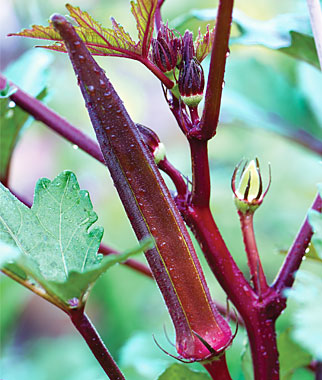
PAWPAW Carica papaya also ka as papaya
One of the first fruiting plants I noticed as a kid. My Gran would tell me that they liked Epsom Salts so I’ve never forgotten and always give mine a handful a couple of times a year.
Some people call them Pawpaw some call them Papaya – the red seems to be known as the latter and the yellow as the former, I know them just as Pawpaw. Trees can come in male or female or bi-sexual. The ones predominately growing in my yard were self sown (bird poop??) and produce wonderfully for me and last for years. The plants I buy prove to be not nearly so hardy. I hanker after a good red pawpaw plant but they don’t do as well as the yellow self sown ones for me.
The fruit contains the enzyme Papain, found in meat tenderiser. There are many pawpaw ointment products out there for skin treatment. Personally I’m allergic to these products on my skin but can eat the fruit, go figure.
Many people don’t like to eat the ripe fruit. The eye opener for me is that they make a great vegetable when green and this is how I use most of mine these days. Used a lot in Asian cooking, grated they make a delicious salad and I personally like them roasted and in stews and casseroles. I think they taste like a good sweet turnip with much the same texture when cooked.
The picture shows my best producer, now dead and gone but replaced by some of it’s own seedlings. It is multi stemmed because the top broke off during a storm while laden with a huge amount of fruit, but like a trooper it kept growing.
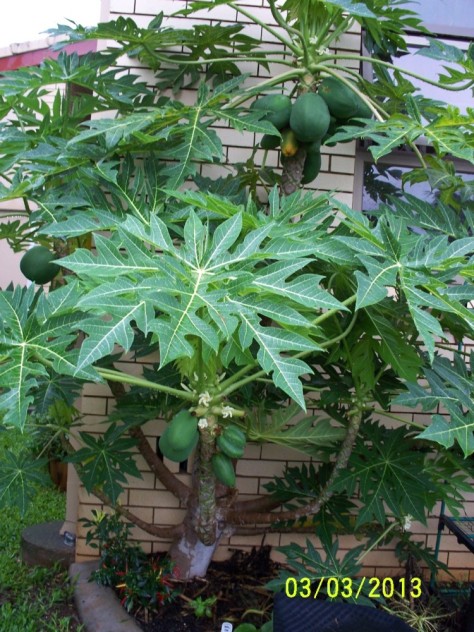
A versatile plant used a lot in permaculture gardens. Useful as bee food source, animal fodder, edible seeds and mulch. Dahl recipe

PIGFACE Carpobrotus glaucescens
Every part of this plant is edible and/or medicinal – the leaves can be used like aloe vera to lessen stings and burns of the skin, as well as eaten raw or cooked.
Pigface has been eaten and used extensively by the peoples of Australia for as long as there’s been people here. Fruit can be used for jams and jellies and the leaves cooked as vegetables.
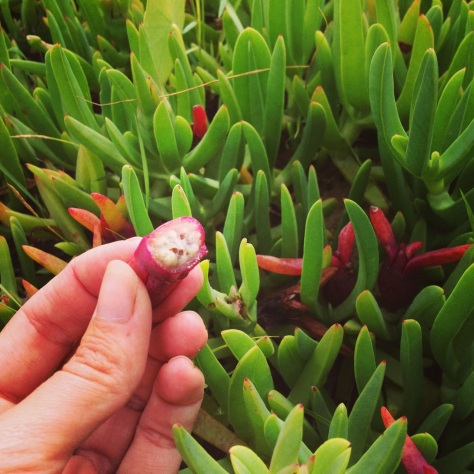
PURPLE YAM Dioscorea alata ka Winged Yam, Greater Yam
A climber that can be let loose on a tree as the edible bits are under the ground. Dies back in winter. Tubers can be white or purple in the middle – purple are for sale at Yandina Community Gardens. The purple colour remains when cooked and can make for some interesting looking food.
Can be used in a number of ways in cooking including as an ingredient in cakes and icecream, but roasted was recommended at the Yandina workshop. Doesn’t need as much time to cook as a regular potato – should be crispy on the outside and soft on the inside. If you boil or steam keep it seperate from other veg as it tends to go mushy cooked this way. Yam & Madagascar Bean salad recipe.

SAMPHIRE Crithmum maritimum also ka sea asparagus, swamp grass, salicorne, glasswort, pickleweed and sea beans
Samphire is considered best for use in summer (in season October to March) when the fleshy leaves are bright green and aromatic. In Winter the leaves turn a reddish/ pink but there is still some green to be found at the base of the plants. Blanching winter samphire before cooking gives a lovely, salty taste of the sea.
Crunchy in texture, it gives a salty fresh burst of flavour which is reminiscent of asparagus. Fine young shoots that are bright green are the best to use raw, cooking can be a quick blanch, or sauté and toss with macadamia or olive oil, garlic and onion.
Pairs well with our abundant seafood and is wonderful in salads, pesto and salsa verde or as a garnish.
June 2015 – I have bought some seed on eBay and hope to finally start growing this plant.

SOCIETY GARLIC Tulbaghia violacea
A pretty, hardy little perennial plant, that I’m told is used for the edible flowers and stalks, does not produce a garlic bulb.

SWEET LEAF Sauropus androgynus also ka Katuk
Thank you to gardening friend James for encouraging me to grow this pleasant little annual and providing me with my first plant. This plant likes it’s water and grows best in the humid months, dying back in winter. Easy to grow from cuttings which can be struck in water or stuck directly into the ground if kept protected. The leaves (mostly the tips) are used in Asian cooking but lend themselves to salads and general green food use.
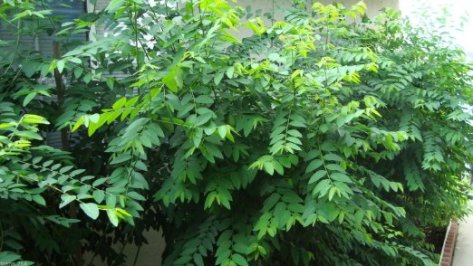
SWEET POTATO Ipomoea batatas belongs to the family Convolvulaceae

These are incredibly easy to grow all year round here in Brisbane, unlike regular potatoes.
I prefer to grow mine in grow bags with a frame to grow up – we call them Sweet Potato Towers.This method encourages more leaf growth (leaves are edible and I use them a lot in stews etc – gardening friend Andy makes pesto out of his) which promotes a better crop of tubers. I’ve found I grow just as many tubers in one of these grow bags as I do if I let a plant loose to take up heaps of space in one of the general beds.
Swt Potato come in a variety of colours – I’m personally not that fond of the common gold variety (hate to think I’m a potato snob, but I just don’t like the squishy texture or flavour). I do grow the purple/purple, purple/white and white/purple varieties. Each newly planted bag is ready to crop within about 4months. Follow the link to the full blog or check out the photos below for easy propagation technique.

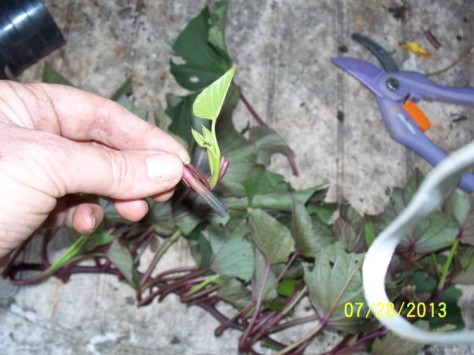

Now I know I’m not alone getting Taro and Tahitian Spinach and Cocoyam mixed up.
The Taro leaves need to be cooked whereas the Tahitian Spinach can be eaten raw – something Robyn did on the day to prove her point.
All three plants like their moisture. Wet spots would suit them.
Taro and Cocoyam leaves are full of Oxalic Acid. Do not eat them raw! (I made this mistake and it was like swallowing pins). While the leaves are edible if cooked to remove the acid, Robyn suggests we use Taro for the edible tubers and stick to Tahitian Spinach for the leaves and stems.
Cocoyam leaf (below) looks similar to Taro leaf.

TAHITIAN SPINACH Xanthosoma brasiliense

I have developed a great fondness for Tahitian Spinach aka Celery Stemmed Taro. Great plant. Negligible Oxalic Acid and can be eaten raw (I watched someone do it at a workshop at Yandina).
It is not Cocoyam despite the common name in the link. It is also not Taro. See seperate listings for these two plants.
Wish I had a wet spot to get the Tahitian Spinach growing a bit more abundantly.
Another useful spice plant with a distinctive deep orange colour to the rhizome. In Indonesia, the young shoots and rhizome tips are eaten raw. Gardening friend Elaine swears by it added to roast veg.

WARRIGAL GREENS Tetragonia tetragoniodes also ka New Zealand Spinach
Its medium to low levels of oxalates (Oxalic Acid) need to be removed by blanching the leaves in hot water for one minute, then rinsing in cold water before cooking. Grows wild on the east coast. Used by Cook and his sailors to ward off scurvy.
I found these to be very palatable steamed or used in general cooking. Although they grow wild along the sandy foreshore around here I have seen them flourishing in a community garden bed looking much more abundant and appealing.

WATER CHESTNUT Eleocharis dulcis also ka chinese waterchestnut, apulid, haeo chin, cu nang, ma tai, ohkuru guai
I grow mine in a clay pot of quality potting mix and Organic Xtra partially submerged in another tub of water. I have heard all sorts of complicated theories about growing these but if you just put them into a pot like this and make sure the outer pot does not dry out, they grow well with little attention.
Crop once a year when the sedge like growth turns yellow and dies off. The little corms keep well in the fridge for weeks if sealed off with a bit of water to keep them moist . I replant immediately using the smallest corms but they could be stored in the fridge for a while if need be. Can be frozen but these are no use for planting once defrosted. Overcrowding your replant will produce a reduced yield.
I wash mine before chopping. I no longer try to peel them. I just don’t have that kind of patience or time to spare and besides, the fibre is good for you. Very delish in stir fries and stews they add a nice crunchy texture.

WEST INDIAN ARROWROOT Maranta arundinacea also ka arrowroot, maranta, obedience plant, Bermuda arrowroot, araru, ararao, hulankeeriy, Indian Arrowroot. Maranta Indica, Maranta ramosissima. Maranta Starch or Arrowroot, East or West Indian Arrowroot, Araruta, Bermuda Arrowroot, Bamboo Yam
Gardening friend Janet grows some interesting plants and posted information about this delicious and versatile plant recently. A sharing sort of person Janet has given out bits for the rest us to try! I roasted one tuber from the bits given and it was crunchy and delicious. I’ve grown these decoratively for years and never had any notion that they were edible. What a find! Very useful as a chop and drop plant for mulch as well if it becomes over abundant.
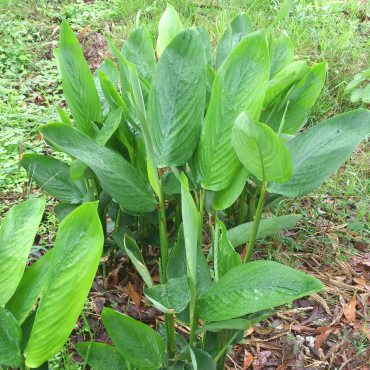

WINGED BEANS Psophocarpus tetragonolobus also ka Goa bean, asparagus pea, four-angled bean, four-cornered bean, Manila bean, Mauritius bean, and winged pea
Highly recommended to grow by the ladies at Yandina Community Garden. Eat them when the pods are small and crunchy. Good raw in salads or used in stir fries. It’s a perennial plant that can last for years with a yearly cut back.

YACON Smallanthus sonchifolius (formerly Polymnia sonchifolia) also ka Peruvian ground apple, strawberry jicama, Bolivian sunroot, llacon, groundpear, pear of the earth
One of my personal favourites, tasting like a cross between a sweet carrot and an apple.
Crops once a year. Pink material at the top is used to propagate next years crop while the tubers are eaten. Crunchy and sweetish – good for diabetics as the sugar is Inulin.
The ladies at Yandina had some dried which made a nice sweet treat. This can also be pounded in a mortar and pestle to produce a sweetener.
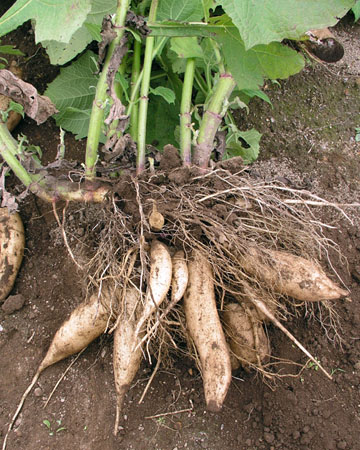


I am utterly gobsmacked at the amount of quality information you have produced in this blog post. What an amazing resource! I live in Tasmania. Hardly semi-tropical but thanks to my close proximity to a large river and our steep 4 acre block we have very little risk of frost (let alone anything else Tasmania can throw at us) and I have a lot of luck growing plants that wouldn’t be considered Tassie safe, let alone contemplated to be grown in a local garden. Cheers for this amazing post. It is an awesome collective and will be most useful in the future for many people 🙂
LikeLike
Thanks Narf 🙂 that’s very kind.
It came about because new members to the group would ask the same (important) questions about what to grow in sub-trop Brisbane. It is my own private interest as well. What an eye opener when I began to learn a mere few years back that all these alternatives were out there. It’s taken some re-educating of the palate to get used to eating some of them but many taste no different in cooking than their more common store bought cousins.
Things like the Purple Yam with it’s slimy texture I can’t favour over a regular spud…but then regular spuds don’t grow well here for us most of the year, so I’ve got to learn to use the alternatives or find some more palatable ones. The thrill of the hunt 🙂
Many of the plants in this blog would grow for you in Tassie I’m sure. Things like Oca grow in NZ – they should grow better for you than they did for me – which was not at all! The Pigface and Samphire are collected from beaches all around the world. Do you grow Yakon and Jicama down there? Surely they would grow for you. No harm in trying anyway. I would love to hear how you go if you do try some of them.
Do you grow Swt Potato successfully?
LikeLike
I’ve added three extra plants this morning – pawpaw, nopales and maranta. And later Moringa and Sweetleaf.
LikeLike
Thanks for this info Lisa, I haven’t heard of some of these
LikeLike
No worries Cheryl 🙂
If you hear of any other interesting sub trop or alternative veg let me know and I’ll add them to the list. Information needs to be shared! 😀
LikeLike
Lots of excellent first hand knowledge there.
Thanks for writing that.
It really motivates me to try some of those plants and techniques.
LikeLike
Thanks jmercer 🙂 Always good to have been useful to someone. If you are in Brissie and want cuttings just let me know.
LikeLike
Thanks Lissa for your generous offer,
but I live down in Sydney.
I will definitely be trying some of those sweet potato towers.
I have some slips growing in pots, but it would be too late to start this season I guess.
LikeLike
They’re just sweet potato cuttings Jeff, why not give them a go anyway? Not sure of the climate in Sydney but I don’t think it’s all that different from ours here. Find a warm spot in the garden. Microclimate can be everything.
LikeLike
I want to write and I wonder how to start a blog for people on this yahoo community. .
LikeLike
Hi North West Glaziers
This is Word Press which has nothing to do with Yahoo as far as I know.
Contact Word Press is my best suggestion, and make some enquiries.
All the best
Lissa
LikeLike
Good web site and happy messages. I favor it. Thanks for your time master
LikeLike
Thank you for reading 🙂
LikeLike
this is a fantastic collection of plants, so informative! I grow a few of these and am willing to try the rest. I live in FL and after starting to garden here, very few traditional veggies can take our summer heat and humidity. So, looking for alternatives.
Have you tried Surinam Spinach, it’s my new favorite in the subtropical greens category!
LikeLike
Thanks for the feedback Nika 🙂
Yep, grown Surinam Spinach. There are lots of tasty versatile greens out there to try. Currently growing Chaya or Spinach Tree https://www.daleysfruit.com.au/Chaya-Spinach-Tree-Cnidoscolus-aconitifolius.htm
My favourite remains the Collard Greens.
FL I take it is Florida? Similar to our sub tropical climate here in SE Queensland.
LikeLike